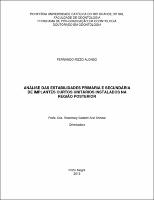| Compartilhe o registro |


|
Use este identificador para citar ou linkar para este item:
https://tede2.pucrs.br/tede2/handle/tede/1225| Tipo do documento: | Tese |
| Título: | Análise das estabilidades primária e secundária de implantes curtos unitários instalados na região posterior |
| Autor: | Alonso, Fernando Rizzo  |
| Primeiro orientador: | Shinkai, Rosemary Sadami Arai |
| Resumo: | Evidências clínicas sugerem que a estabilidade dos implantes exerce um papel importante no sucesso da osseointegração. No entanto, não há informações suficientes a respeito da estabilidade de implantes curtos (6-mm). Diante disso, os objetivos deste estudo foram: 1) avaliar clínica e longitudinalmente a estabilidade de implantes curtos em função da qualidade óssea, através do torque de inserção, análise da frequência de ressonância (RFA) (Osstell®) e capacidade de amortecimento (PTV) (Periotest®); e 2) avaliar a correlação entre as três técnicas. Foram instalados 39 implantes (Straumann, SLActive, 4.1 x 6 mm), de 1 estágio cirúrgico, na região posterior de maxila e mandíbula, em 18 pacientes com idade entre 25 e 76 anos. A qualidade óssea foi identificada pela sensibilidade tátil do cirurgião no momento da perfuração e classificada de acordo com a classificação de Lekholm & Zarb (1985) (tipos I-IV). O torque de inserção foi medido utilizando um torquímetro manual (Straumann®), e dividido em três grupos: < 15 Ncm, entre 15 e 35 Ncm e >35 Ncm. Os valores PTV foram medidos imediatamente após o torque manual, no montador do implante. Para os valores de RFA foi calculada a média das medidas mésio-distal e vestíbulo-lingual. A avaliação de RFA e PTVs foi repetida no momento da instalação da coroa (3 meses mais tarde). Os resultados mostraram efeito significativo da qualidade óssea nos valores de estabilidade do implante. Os valores do torque de inserção foram significativamente maiores no osso tipo 1-2 do que em osso tipo 3 e 4. Para os valores PTV foi encontrada diferença estatística entre o osso 1-2 e 4. Analisando os valores RFA, os implantes instalados em osso tipo 1-2 e 3 apresentaram ISQ significativamente maior do que os implantes instalados em osso tipo 4. Além disso, independente do tipo de osso, as médias dos valores de ISQ foram significativamente maiores após o período de osseointegração (79,36) do que no momento da instalação do implante (68,29). Os resultados demonstraram que a qualidade óssea influencia nos valores de estabilidade primária e secundária, havendo correlação moderada entre os três métodos de avaliação da estabilidade. |
| Abstract: | Clinical evidences suggest that the stability of dental implants plays an important role on the success of osseointegration. However, there is not sufficient information with respect to the stability of short (6-mm long) implants. Thus, the aims of this study were: 1) to assess clinically and longitudinally the stability of short implants in relation to the bone quality, by means of insertion torque, resonance frequency analysis (RFA) (Osstell®) and damping capacity (PTV) (Periotest®); and 2) to evaluate the correlation among these three techniques. Thirty-nine one-stage implants (Straumann®, SLActive, ø4.1 x 6-mm long) were placed in the posterior region of the maxilla and the mandible in 18 patients with ages ranging between 25 and 76 years old. The bone quality was identified by the surgeon s tactile sensitivity at the moment of the perforation and classified according to the Lekholm & Zarb classification (1985) (types I-IV). The insertion torque was measured using the manual wrench (Straumann®) and divided into three groups: <15 N.cm, between 15 and 35 N.cm and, finally, >35 N.cm. The PTV values were measured immediately after the manual torque, at the implant assembler level. For the RFA values, a mean was calculated for the mesio-distal and bucco-lingual measurements. The RFA and PTVs assessments were repeated at the moment of the crown installation (3 months later). The results showed a significant effect of bone quality on the stability values of the implant. Insertion torque values were significantly higher for bone types I-II than for bone types III and IV. Statistical difference was found only for PTV values between bone types I and II compared to bone type IV. For the RFA values, implants placed in types I-II and III presented ISQ significantly higher than implants placed in type IV bone. Besides that, regardless of the type of bone, the mean ISQ values were significantly higher after the osseointegration period (mean=79.36) than that at the moment of the placement of the implant (mean=68.29). The results of this study showed that bone quality influences on the values of primary and secondary stability, presenting moderate correlation among the three methods of stability assessment. |
| Palavras-chave: | ODONTOLOGIA IMPLANTODONTIA IMPLANTES DENTÁRIOS OSSEOINTEGRADOS OSSEOINTEGRAÇÃO (ODONTOLOGIA) |
| Área(s) do CNPq: | CNPQ::CIENCIAS DA SAUDE::ODONTOLOGIA |
| Idioma: | por |
| País: | BR |
| Instituição: | Pontifícia Universidade Católica do Rio Grande do Sul |
| Sigla da instituição: | PUCRS |
| Departamento: | Faculdade de Odontologia |
| Programa: | Programa de Pós-Graduação em Odontologia |
| Citação: | ALONSO, Fernando Rizzo. Análise das estabilidades primária e secundária de implantes curtos unitários instalados na região posterior. 2013. 53 f. Tese (Doutorado em Odontologia) - Pontifícia Universidade Católica do Rio Grande do Sul, Porto Alegre, 2013. |
| Tipo de acesso: | Acesso Aberto |
| URI: | http://tede2.pucrs.br/tede2/handle/tede/1225 |
| Data de defesa: | 27-Mai-2013 |
| Aparece nas coleções: | Programa de Pós-Graduação em Odontologia |
Arquivos associados a este item:
| Arquivo | Descrição | Tamanho | Formato | |
|---|---|---|---|---|
| 450848.pdf | Texto Completo | 1,57 MB | Adobe PDF |  Baixar/Abrir Pré-Visualizar |
Os itens no repositório estão protegidos por copyright, com todos os direitos reservados, salvo quando é indicado o contrário.




